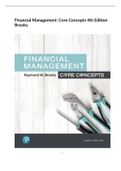Exam (elaborations)
Financial Management Core Concepts 4th Edition.pdf
- Institution
- University Of Alberta (UofA)
Financial Management Core Concepts 4th E Financial Management: Core Concepts, 4e (Brooks) Chapter 1 Financial Management 1.1 The Cycle of Money 1) At its most basic level, the function of financial intermediaries is to ________. A) track and report interest rates B) move money from lenders to...
[Show more]



